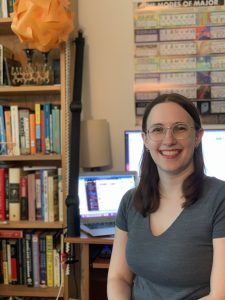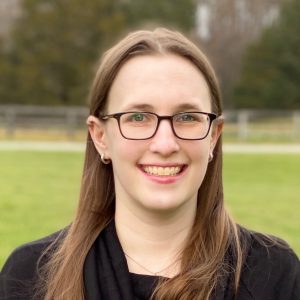
What I’m working on:
The November issue of Scientific American! I edit the short news section called Advances at the front of the print magazine, which means in a given month I’m assigning and editing a bunch of 300- to 400-word stories (and one longer opener), as well as meeting with the art team to discuss images, graphics, and layout. At this point, 12 stories for this month have already been edited, top edited, and sent to the copy desk, and I’m still waiting on one of them to come back from an author. I’m also editing a couple of fun web stories right now, but because I’m not sure when this interview will come out I’m not going to tease what those are!
Where I work:
The living room of my one-bedroom apartment on the Upper East Side. (My husband’s “office” at the moment is a card table in the bedroom.) I’m potentially going back into the actual office for the first time next week, so I may eventually shift to a hybrid schedule of a few days in the office and a few days at home.
Daily routine:
Right now it’s pretty bare-bones but will presumably change if/when I’m regularly traveling into the office. After I wake up I’ll play through a bit of Ring Fit Adventure or do a different workout, or just hang out and read the internet for a bit, before getting ready for the day and jumping into edits.
My workday changes a lot based on the part of the production cycle we’re in: Sometimes I’m reading pitches and assigning stories for Advances. Sometimes I’m editing and going back and forth with authors to hone stories into their best possible versions at, say, 400 words. Sometimes I’m reading through the month’s layout to try and make last-minute changes for clarity and length (which is when I regret assigning too many stories that are on the longer end of the word range). On any given day I’m also editing stories for the web, fielding emails, looking up website traffic for particular stories/topics, attending virtual meetings, and supervising interns or fellows—especially trying to make sure they have the chance to interact with lots of different editors despite the fact that we’re not all in the office together. (When the chief news editor is out, I also fill in for him, shifting the balance of my job a lot further to the web side.)
I eat breakfast and lunch during the workday, and I run various errands, have dinner, and watch streaming shows with my husband in the evening (right now, Star Trek: Lower Decks or Only Murders in the Building, if a new one’s come out).
Most productive part of my day:
Hard to predict, but I do tend to get a lot done in the late afternoon. My job involves a lot of jumping into action as soon as someone sends me a draft, edit, or layout, as well, which can happen at any point.
Most essential ritual or habit:
Unfortunate pandemic answer, but going outside every day. I hadn’t expected at first how big a difference that would make to my general well-being, and I’m generally pretty happy to just sit around and read, but going out just to walk around the block or to pick up some groceries—or working from my building’s roof when the weather is nice—makes me feel way better overall.

Favorite note-taking techniques/tools:
At my old job at Space.com I used to sometimes borrow a pen to use at conferences that would record audio and also had a little camera that digitized handwritten notes as I wrote. That thing was amazing. At my current job I’m never reporting on anything in person so I usually just take notes in OneNote; while it isn’t that responsive on my current work computer, it does have all my science-writing notes dating back to 2013 (that aren’t in physical notebooks), so there’s a nice continuity to still using it.
How I keep track of my to-do list:
First off, I have a giant, fun spreadsheet on Google Sheets with a page for each month’s Advances section that lets me document where each story is, project spending for the rest of the year, and do other neat calculations when I feel like it. (Plus, I can check records from previous Advances editors to track authors, story topics, word counts, and fees.) Second, the potentially unusual strategy I’ve been following these days involves the little colorful tags you can put beside files on Macs; I mark individual story folders with “red” when they’re first filed, and go through a succession of different colors as they pass through different parts of the editorial process. These also correlate with my stress levels: I do everything I can to get rid of the “red” stories; if a story is on “blue” or “purple” (with the author or with a top editor) I can relax about it; “orange” means I need to get going again on edits, and “yellow” means it’s almost out of my hands. For non-story-based tasks, I rely on calendar alerts or giant notes on random scrap paper saying something like “EMAIL EMILY.”
Essential software/apps/productivity tools:
Besides fiddling around with the aforementioned spreadsheet and potentially a couple other bonus spreadsheets—I really like spreadsheets—I make sure I have a Google Drive backup of my key folders that auto-syncs, so I don’t have to worry about losing Word documents if my computer suddenly self-destructs. Since OneNote also auto-syncs, and email can be accessed remotely, I don’t have to worry too much about being brought down by my own technological hubris … I hope.
Favorite time waster/procrastination habit:
Probably looking at all the stuff people are giving away for free online through Freecycle and my local buy-nothing group. Not sure what I’d do with 60 desktop LCD monitors, but it makes me happy that someone’s trying to give them away.
My reading habits:
I’ve been reading a lot of fiction borrowed virtually from the New York Public Library; whenever I hear about a vaguely interesting book I’ll see if there’s an e-book I can reserve, and then am pleasantly surprised/confused when it shows up on one of my library apps a few weeks or months later. I read a couple advice columns regularly for fun, and I read too many news stories shared on Twitter (but it helps me stay up to date for work!). I don’t read as much nonfiction, but I did recently go through Why Fish Don’t Exist by Lulu Miller and Wild Souls by Emma Marris, both of which were excellent. I’m just getting started on The Disordered Cosmos by Chanda Prescod-Weinstein.
Sleep schedule:
I typically get in bed at around 11:00, and I ideally wake up naturally around 7:30—if not, 8:30 is when my alarm goes off. I do sometimes have a lot of trouble falling asleep; I track those instances on a little paper calendar to look for patterns and try out different strategies. Maybe I should start a spreadsheet.


